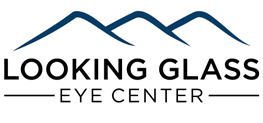Blepharoplasty
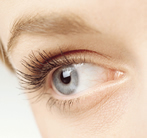 As we mature, the delicate skin around the eyes can appear puffy, saggy, or droopy. Eyelid skin stretches, muscles weaken, and the normal deposits of protective fat around the eye settle and become prominent. Sometimes excess upper eyelid tissue obstructs the upper visual field or can weigh down the eyelid and cause the eyes to feel tired.
As we mature, the delicate skin around the eyes can appear puffy, saggy, or droopy. Eyelid skin stretches, muscles weaken, and the normal deposits of protective fat around the eye settle and become prominent. Sometimes excess upper eyelid tissue obstructs the upper visual field or can weigh down the eyelid and cause the eyes to feel tired.
The surgical procedure to remove excess eyelid tissue (skin, muscle, or fat) and restore a more youthful appearance is called blepharoplasty. It can be performed on the upper eyelid, lower eyelid, or both. When blepharoplasty is performed to improve vision rather than for cosmetic reasons only, the costs may be covered by your health insurance plan including Medicare.
Blepharoplasty is performed in our office and takes one to two hours. Local anesthesia is used, incisions are made in the natural crease of the eyelid, and fine sutures close the skin. Swelling and bruising are common after surgery but this resolves over time.
All of our surgeons perform blepharoplasty and can evaluate you as a candidate and answer any questions.
Ptosis
Ptosis is drooping of the upper eyelid. The eyelid may droop only slightly or it may cover the pupil entirely. In some cases, ptosis can restrict and even block normal vision.
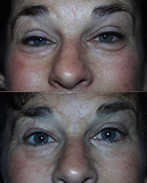 Congenital ptosis, or ptosis that is present at birth, requires treatment in order for normal visual development to occur. Uncorrected congenital ptosis can cause amblyopia or “lazy eye”, which is an impaired visual development. If left untreated, amblyopia can lead to permanently poor vision.
Congenital ptosis, or ptosis that is present at birth, requires treatment in order for normal visual development to occur. Uncorrected congenital ptosis can cause amblyopia or “lazy eye”, which is an impaired visual development. If left untreated, amblyopia can lead to permanently poor vision.
Ptosis in adults is commonly caused by separation of the levator muscle from the eyelid as a result of aging, cataract or other eye surgery, an injury, or an eye tumor. Adult ptosis may also occur as a complication of other diseases such as diabetes that involve the levator muscle or its nerve supply.
If treatment is necessary, it is usually surgical. Sometimes a small tuck in the levator muscle and eyelid can raise the lid sufficiently. More severe ptosis requires reattachment and strengthening of the levator muscle. Although improvement of the lid height is usually achieved, the eyelids may not appear perfectly symmetrical. In rare cases, full eyelid movement does not return.
Entropion
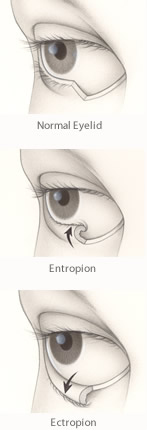 Entropion is an inward turning of the eyelid and lashes toward the eye, usually caused by relaxation of the eye muscles and tissue due to aging.
Entropion is an inward turning of the eyelid and lashes toward the eye, usually caused by relaxation of the eye muscles and tissue due to aging.
Entropion usually affects the lower lid. The skin and eyelashes rub against the eye and cause discomfort and tearing. The irritated eye can produce mucus and become red and sensitive to light. If entropion is not treated, rubbing of the skin and eyelashes can lead to infection or scarring of the eye, which can cause vision loss.
Surgery can be performed to tighten the eyelid and return it to its normal position. The eyelid then protects the eye properly, and irritation and other symptoms subside.
Ectropion
Ectropion is an outward turning of the lower eyelid, most commonly caused by aging, although eyelid burns or skin disease may also be responsible.
Normally, the eyelids help lubricate and cleanse the eye during blinking. An eyelid that is drooping and has lost contact with the eye can cause dryness or excessive tearing, redness, and sensitivity to light and wind.
Surgery can be performed to tighten the eyelid and return it to its normal position. The eyelid can then protect and lubricate the eye properly, so that irritation and other symptoms subside.
Facial BOTOX®
Dynamic wrinkles are created by contraction of the facial muscles every time you smile, squint, laugh, frown or cry. BOTOX® is a purified form of botulinum toxin which blocks nerve impulses to the fine facial muscles that cause lines of expression over time. By blocking these nerve impulses, the muscles and overlying skin will flatten, lessening appearance of wrinkles in treated areas.
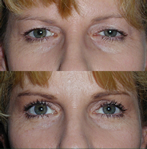 BOTOX® injections are performed as a simple and safe office based procedure. Your personal goals will be discussed with your physician before beginning the procedure. A very fine needle will be used to inject precisely into several locations on the face. Minimal pain is associated with the injections. You should be able to drive yourself back home or to work after the injections. A small amount of bruising may occur around the injection sites, but can be concealed with makeup.
BOTOX® injections are performed as a simple and safe office based procedure. Your personal goals will be discussed with your physician before beginning the procedure. A very fine needle will be used to inject precisely into several locations on the face. Minimal pain is associated with the injections. You should be able to drive yourself back home or to work after the injections. A small amount of bruising may occur around the injection sites, but can be concealed with makeup.
Onset of action of BOTOX® may be immediate but may not begin for up to 24 hours. The maximum effects of the injections are usually seen at approximately one week following injections. The effects of Botox typically last 3-6 months.
BOTOX® treats dynamic wrinkles only and does not have a permanent effect. Since effects last from 3-6 months, the procedure will need to be repeated a couple of times a year although repeat injections may ultimately lead to longer lasting effects. BOTOX® cannot treat deep wrinkles or those due to aging or prolonged sun exposure as these are not expression induces wrinkles.
For more information visit www.BOTOXcosmetic.com
Latisse™
Latisse is the exciting new prescription solution used to treat hypotrichiasis. Hypotrichiasis is the medical term for having a paucity of or not enough eyelashes. The application of Latisse makes eyelashes grow longer, thicker and darker.
All patients interested in using Latisse should consult their Eye Care Physician before beginning treatment. If you ar a patient with a history of elevated eye pressure or use prescription eye drops to lower your eye pressure use Latiesse only under close supervision by your doctor.
Looking Glass Eye Center is proud to be an official dispensing center for this new Allergan product.
For complete information regarding Latisse, consult www.latisse.com
